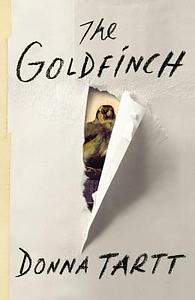Take a photo of a barcode or cover
dark
reflective
sad
medium-paced
Plot or Character Driven:
Character
Strong character development:
Yes
Loveable characters:
Yes
Diverse cast of characters:
No
Flaws of characters a main focus:
Yes
"We have art in order not to die from the Truth.” — Nietzsche
The Goldfinch ticked so many boxes for me—a sweeping, character-driven novel that blends art, atmosphere, and emotional depth in a way that’s hard to forget.
Tartt’s ability to evoke a strong sense of place stood out immediately. From Theo’s childhood stomping ground between the Upper East Side and Midtown Manhattan, to the haunting sprawl of Las Vegas suburbia—where half-built homes are slowly reclaimed by desert sands and neglect—the settings mirror Theo’s fractured internal journey. Tartt's writing made it easy to imagine walking the avenues with Theo, feeling the weight of the city and the ache of displacement.
The true strength of this book lies in its characters. At 864 pages, Tartt has the space to truly flesh out a rich cast beyond just Theo. Boris—unapologetic, witty, chaotic—is one of my favourite fictional characters of all time, and the way Tartt draws out figures like Andy, Hobbie, and Mrs. Barbour made each of them feel authentic. You don’t just read about these people—you come to know them.
As an art-lover, I also found deep pleasure in the aesthetic undercurrents of the story. Anchored by Fabritius’s The Goldfinch, the book is scattered with references to painting, antiques, and craftsmanship. I was constantly googling the artworks mentioned throughout—curious to see what Theo saw, and to understand the emotion and significance behind each piece. It felt like a self-guided museum tour, threaded through the pages of a deeply personal story.
After finishing the novel, I watched the 2019 film adaptation. Although beautifully shot, I found it couldn’t quite capture the depth and nuance of the characters I’d grown so attached to. However, Nicole Kidman was a standout—she did an admirable job of bringing Mrs. Barbour to life, capturing her cold elegance and quiet complexity in a way that reflected the character I imagined on the page.
The Goldfinch ticked so many boxes for me—a sweeping, character-driven novel that blends art, atmosphere, and emotional depth in a way that’s hard to forget.
Tartt’s ability to evoke a strong sense of place stood out immediately. From Theo’s childhood stomping ground between the Upper East Side and Midtown Manhattan, to the haunting sprawl of Las Vegas suburbia—where half-built homes are slowly reclaimed by desert sands and neglect—the settings mirror Theo’s fractured internal journey. Tartt's writing made it easy to imagine walking the avenues with Theo, feeling the weight of the city and the ache of displacement.
The true strength of this book lies in its characters. At 864 pages, Tartt has the space to truly flesh out a rich cast beyond just Theo. Boris—unapologetic, witty, chaotic—is one of my favourite fictional characters of all time, and the way Tartt draws out figures like Andy, Hobbie, and Mrs. Barbour made each of them feel authentic. You don’t just read about these people—you come to know them.
As an art-lover, I also found deep pleasure in the aesthetic undercurrents of the story. Anchored by Fabritius’s The Goldfinch, the book is scattered with references to painting, antiques, and craftsmanship. I was constantly googling the artworks mentioned throughout—curious to see what Theo saw, and to understand the emotion and significance behind each piece. It felt like a self-guided museum tour, threaded through the pages of a deeply personal story.
After finishing the novel, I watched the 2019 film adaptation. Although beautifully shot, I found it couldn’t quite capture the depth and nuance of the characters I’d grown so attached to. However, Nicole Kidman was a standout—she did an admirable job of bringing Mrs. Barbour to life, capturing her cold elegance and quiet complexity in a way that reflected the character I imagined on the page.
dark
emotional
mysterious
medium-paced
Plot or Character Driven:
A mix
Strong character development:
Yes
Loveable characters:
Complicated
Diverse cast of characters:
No
Flaws of characters a main focus:
Yes
emotional
funny
hopeful
reflective
slow-paced
Plot or Character Driven:
A mix
Strong character development:
Yes
Loveable characters:
Yes
Diverse cast of characters:
Yes
Flaws of characters a main focus:
Complicated
adventurous
challenging
dark
emotional
funny
mysterious
reflective
sad
tense
medium-paced
Plot or Character Driven:
A mix
Strong character development:
Yes
Loveable characters:
Complicated
Flaws of characters a main focus:
Yes
adventurous
emotional
hopeful
mysterious
medium-paced
Plot or Character Driven:
A mix
Strong character development:
Yes
Loveable characters:
Complicated
Diverse cast of characters:
Yes
Flaws of characters a main focus:
Yes
challenging
dark
emotional
tense
slow-paced
Plot or Character Driven:
Character
Strong character development:
Yes
Loveable characters:
Complicated
Diverse cast of characters:
Yes
Flaws of characters a main focus:
Yes
adventurous
challenging
dark
emotional
inspiring
mysterious
reflective
sad
tense
slow-paced
Plot or Character Driven:
A mix
Strong character development:
Yes
Loveable characters:
Yes
Diverse cast of characters:
No
Flaws of characters a main focus:
Complicated
I’m giving this book a two because I don’t remember the last time I had to drag myself through a book this much. Overall it was alright, and there were definitely parts I liked, but so much of it just dragged on with no apparent purpose. The ending also felt unnecessary, each character giving their own philosophical speech, as if the author was really trying to make sure the reader understood what the whole book was getting at, without just letting the reader figure that out for themselves.




